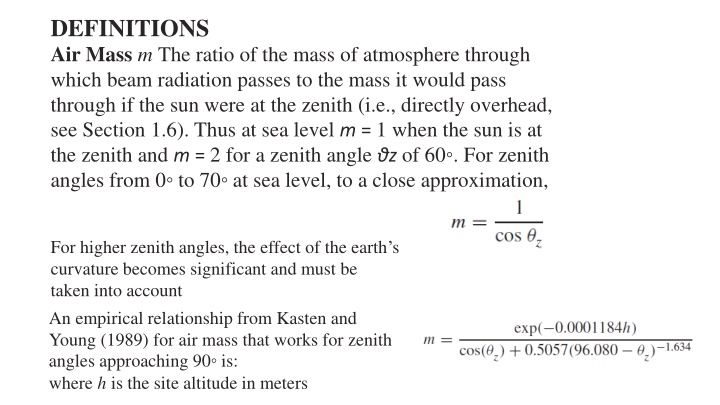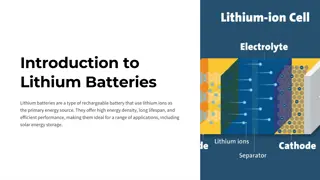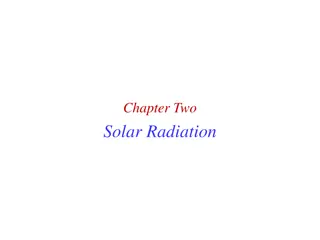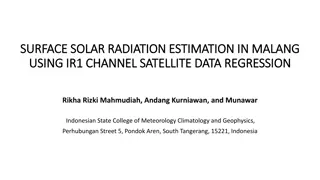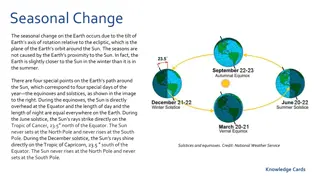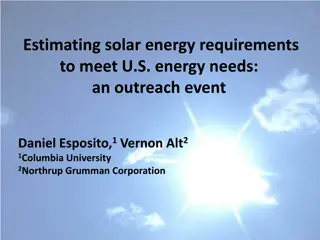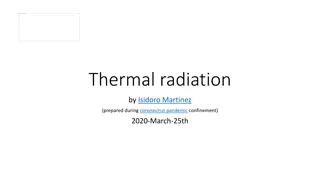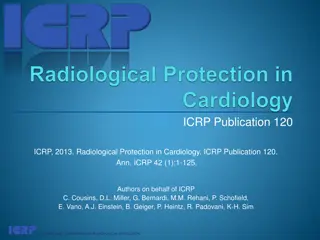Solar Radiation and Energy Terms
Definitions and concepts related to solar radiation, air mass, beam radiation, diffuse radiation, irradiance, insolation, and solar time. Learn about the significance of these terms in understanding solar energy and atmospheric processes.
Download Presentation

Please find below an Image/Link to download the presentation.
The content on the website is provided AS IS for your information and personal use only. It may not be sold, licensed, or shared on other websites without obtaining consent from the author.If you encounter any issues during the download, it is possible that the publisher has removed the file from their server.
You are allowed to download the files provided on this website for personal or commercial use, subject to the condition that they are used lawfully. All files are the property of their respective owners.
The content on the website is provided AS IS for your information and personal use only. It may not be sold, licensed, or shared on other websites without obtaining consent from the author.
E N D
Presentation Transcript
DEFINITIONS Air Mass m The ratio of the mass of atmosphere through which beam radiation passes to the mass it would pass through if the sun were at the zenith (i.e., directly overhead, see Section 1.6). Thus at sea level m = 1 when the sun is at the zenith and m = 2 for a zenith angle z of 60 . For zenith angles from 0 to 70 at sea level, to a close approximation, For higher zenith angles, the effect of the earth s curvature becomes significant and must be taken into account An empirical relationship from Kasten and Young (1989) for air mass that works for zenith angles approaching 90 is: where h is the site altitude in meters
Beam Radiation The solar radiation received from the sun without having been scattered by the atmosphere. (Beam radiation is often referred to as direct solar radiation; to avoid confusion between subscripts for direct and diffuse, we use the term beam radiation.) Diffuse Radiation The solar radiation received from the sun after its direction has been changed by scattering by the atmosphere. (Diffuse radiation is referred to in some meteorological literature as sky radiation or solar sky radiation; Total Solar Radiation The sum of the beam and the diffuse solar radiation on a surface.4 (The most common measurements of solar radiation are total radiation on a horizontal surface, often referred to as global radiation on the surface.)
Irradiance, W/m2 The rate at which radiant energy is incident on a surface per unit area of surface. The symbol G is used for solar irradiance, with appropriate subscripts for beam, diffuse. Irradiation, J/m2 The incident energy per unit area on a surface, found by integration of irradiance over a specified time, usually an hour or a day. Insolation is a term applying specifically to solar energy irradiation. The symbol H is used for insolation for a day. The symbol I is used for insolation for an hour (or other period if specified). The symbols H and I can represent beam, diffuse, or total and can be on surfaces of any orientation. Subscripts on G, H, and I are as follows: o refers to radiation above the earth s atmosphere, referred to as extraterrestrial radiation; b and d refer to beam and diffuse radiation; T and n refer to radiation on a tilted plane and on a plane normal to the direction of propagation. If neither T nor n appears, the radiation is on a horizontal plane.
Solar Time: Time based on the apparent angular motion of the sun across the sky with solar noon the time the sun crosses the meridian of the observer. Solar time is the time used in all of the sun-angle relationships; it does not coincide with local clock time. It is necessary to convert standard time to solar time The difference in minutes between solar time and standard time is
